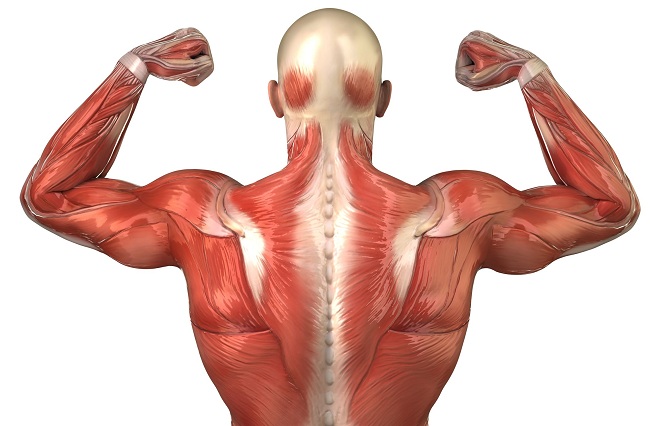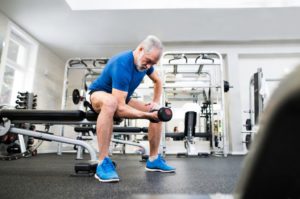5 major benefits of strength training for athletes
By Accredited Exercise Physiologist Aaron Ashdown, Strength & Conditioning Coach (ASCA L2 accredited)
 Strength training is a powerful tool to enhance sporting performance and promote athletic development for all ages and abilities. After initially developing the fundamentals of coordination and basic movement patterns, a periodised strength program can develop a more complete athlete which can then allow for sports specific improvements in speed, power, agility, balance, mobility and reduce injuries in amateur and competitive athletes alike.
Strength training is a powerful tool to enhance sporting performance and promote athletic development for all ages and abilities. After initially developing the fundamentals of coordination and basic movement patterns, a periodised strength program can develop a more complete athlete which can then allow for sports specific improvements in speed, power, agility, balance, mobility and reduce injuries in amateur and competitive athletes alike.
There are many benefits associated with regular strength training, some of which are discussed below.
1. Improve musculoskeletal strength and bone density-
As we know, the human body can adapt to specific stressors allowing us to develop many positive physiological attributes. By performing strength training regularly and placing the body under progressive load, muscles, tendons (the tissue joining muscle to bone to act as an energy transfer and spring) and ligaments (limit motion bone to bone) can all adapt and grow to become stronger.
Similarly, bones can adapt to appropriate forces by also becoming stronger and denser through increases in bone mineral density. By completing specific movement patterns effectively, improvements may also be seen in flexibility and joint mobility leading to a more functional musculoskeletal system that is stronger, more mobile and more resilient.
 Youth and adolescents can also gain positive benefits from strength programs by improving general physical activity levels, developing foundational strength and stability, promoting healthy bone development and encouraging healthy exercise habits for life.
Youth and adolescents can also gain positive benefits from strength programs by improving general physical activity levels, developing foundational strength and stability, promoting healthy bone development and encouraging healthy exercise habits for life.
In contrast, masters’ athletes can also gain positive performance outcomes by maintaining strength and muscle mass, strengthening bones, improving joint mobility and preventing injury throughout the aging process.
2. Increase neuromuscular coordination and movement efficiency-
One of the first physiological adaptations to occur when commencing regular strength training will be improved neuromuscular function, meaning the nervous system will recruit the appropriate muscle fibres at a faster rate and more efficiently whilst exercising. This is especially beneficial to endurance athletes whereby movement efficiency and coordination can be improved to delay the onset of fatigue and reduce the rate of perceived exertion during training and competition.
For example, strength training protocols have been shown to improve running economy which leads to a lower energy cost at a specific effort or pace.
3. Improve power and rate of force development-
 Power production is a combination of force times velocity. As muscles become stronger through strength training, our body has a greater capacity to produce force and combined with an improvement in neuromuscular recruitment (as described above), we are able to apply more force at a greater speed of contraction leading to improved power and explosiveness. This increase in rate of force development can be beneficial to all athletes including team and field sport athletes, track and field as well as endurance and multisport athletes ie. Cyclists, rowers, runners and triathletes.
Power production is a combination of force times velocity. As muscles become stronger through strength training, our body has a greater capacity to produce force and combined with an improvement in neuromuscular recruitment (as described above), we are able to apply more force at a greater speed of contraction leading to improved power and explosiveness. This increase in rate of force development can be beneficial to all athletes including team and field sport athletes, track and field as well as endurance and multisport athletes ie. Cyclists, rowers, runners and triathletes.
Training for power and explosiveness can be done with just an athletes’ own body weight through progressive plyometric exercises such as jumps, hops, skips or bounds or with light-moderate loads lifted at high velocities ie. Olympic weightlifting and variations.
4. Develop optimal body composition and a “performance physique”-
Strength training is one of the best forms of exercise to promote fat loss and achieve optimal body composition due to the fact that strength exercises targeting the major muscle groups will increase metabolism post-exercise for up to 72hrs. Through specific hypertrophy training protocols both Type 1 and Type 2 muscles fibres can increase in size with greater growth in Type 2 muscles fibres, leading to greater muscle mass and a further increase the resting metabolic rate. For certain athletes this muscle mass can be beneficial to their performance whereas other athletes might benefit more from a stronger, leaner physique.
5. Reduce injury risk and correct imbalances-
Strength training can be an effective protocol for reducing risk of injuries by strengthening major muscle groups and the supportive muscles that are essential for the demands of the sport. This strength is important to reduce the prevalence of overuse injuries or imbalances that can accumulate with repetitive training loads.
Given the fact that regular strength training can improve musculoskeletal strength and improve efficiency of movement, the athlete will be able to tolerate greater loads more efficiently, lowering the risk of injury. With specific exercise selection we can train to correct certain imbalances or weakness that may occur as part of our regular training habits.
Periodised strength training usually also form an integral part of the rehab process in the return from injury, by progressively exposing the athlete to appropriate loads and tasks that are specific to the demands of the sport. Throughout the rehab process the athlete will benefit from developing all the attributes listed above, which can all play an important role in the rehab and return to performance pathway.
Summary
- -All athletes should aim to integrate strength training into their training program to develop a healthier and more balanced athlete, to improve sports performance and reduce the risk of injuries.
- -When starting strength training it is best to be conservative and focus on developing safe and efficient movement patterns and posture that will translate to ongoing strength and performance benefits.
- -As the athlete progresses in competency, the best way to improve absolute and relative strength is through a specific periodised strength program using moderate to heavy loads (75-95% of 1RM) with moderate-low repetitions in a variety of complex multi-joint exercises (eg. squat, deadlift, lunge, push, pull). I generally recommend 2-3 sessions per week for most athletes, with a minimum of 30 minutes being beneficial for time-crunched athletes.
 Aaron is available at our Burleigh Clinic to help you in a 1-on-1 session for a supervised strength & conditioning within our clinic gym, or he can consult with you to design a regular strength & conditioning program that you can use at your own gym.
Aaron is available at our Burleigh Clinic to help you in a 1-on-1 session for a supervised strength & conditioning within our clinic gym, or he can consult with you to design a regular strength & conditioning program that you can use at your own gym.
Accredited Exercise Physiologists excel in their roles of devising activity or exercise for athletes as well as disease states like Osteoporosis, Osteoarthritis, Diabetes and many other conditions. Find out more about how Exercise Physiology can help you.
Both our clinics have gym and pilates equipment that you can use for unsupervised sessions (ie independently on your own like a gym), with the current cost only $54 per month (4wks) for unlimited access and no fixed-in contracts. Come and go as you please!
For more information, call us on 07 55006470 or post us a message in our VIP’s of Gold Coast Physio & Sports Health Facebook Group
